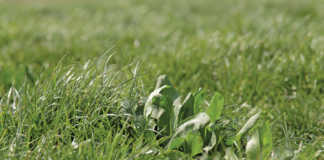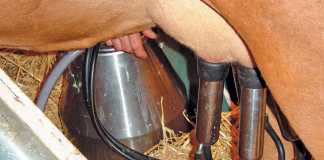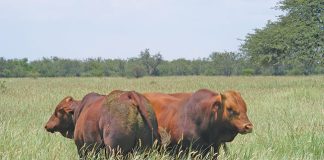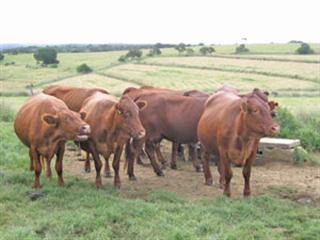
Between Grahamstown and Port Alfred in the Eastern Cape the landscape of Goodwoods farm is a mosaic of valley bushveld, sourveld and planted pastures. Heartwater, redwater, gallsickness and drought are part of life in this area where bush and productive expanses of grass meet in an environment that is as excellent for cattle as it is for ticks and other parasites.
Justin Stirk, who runs a mixed crop and livestock enterprise and has farmed here for 20 years, is in familiar territory. The Stirks have farmed here for four generations, since 1891. “They don’t call this frontier country for nothing,” quips Justin. “ You reap the rewards of farming here, but you also deal with the harsh realities of the Eastern Cape, including extended droughts.”
His farm looks magnificent now, but, as he points out, it didn’t look anything like this during the three year drought from 2008 to 2011. Justin joined his father Dennis on Goodwoods in 1992 after graduating with a BCom at Rhodes, completing his military training and working on a wheat and canola farm in Gloucestershire, England. “That’s where I really learned to work and persevere; 18-hour shifts from 7am to 1am are normal there,” he recalls.
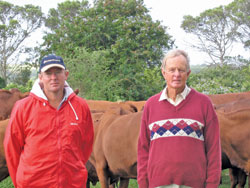
Justin Stirk and his father Dennis on their farm Goodwoods which has been in the Stirk family since 1891.
Goodwoods covers 1 384ha, of which 484ha (35%) is valley bushveld – where the cattle thrive – and 450ha is sourveld on which he runs all his dry stock (cows and sheep). The rest consists of planted pasture, mainly Smuts finger grass (Digitaria eriantha) and Rhodes grass (Chloris gayana) mixes. The Rhodes grass is indigenous to the eastern areas of southern Africa and provides good grazing even in the year of establishment.
He also farms two other blocks of land of 200ha and 370ha respectively, approximately 3km from Goodwoods. Both were formerly planted to pineapple, which he is ploughing up so that the land can be planted to chicory for one year. After this he plans to establish permanent grass pastures.
Smuts finger grass and Rhodes grass thrive on the residual fertiliser left by the chicory, and in this way he can create dryland pasture that will last for 20 years. “It’s highly arable land and provides excellent grazing for cattle,” he explains. He recently bought the 370ha block for R6 000/ha.
Breeding for the environment
The Stirks have effectively been breeding Bonsmara since Justin’s grandfather Neville Stirk first crossed Shorthorns with Afrikaners in the 1930s. “We feel that the Bonsmara is well suited to our conditions,” he explains. “We need functional, adapted cattle that cope with drought and parasites, and then perform well in times of plenty.”
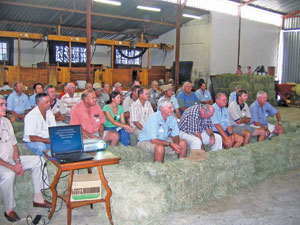
Members of the Mountain View Bonsmaras satellite stud in the Elliot district. From left to right: Mark Lake, Mninawa Qotoyi, Hugh Collet, Glynn Handley and Paul Hobson.
In summer he dips his cattle every two weeks; in winter he keeps a close eye on the tick load and dips accordingly. Justin doesn’t believe there is such a thing as a ‘miracle’ breed. “There is a place for every breed in the country. As long as it performs well and gives us good returns, it’s the breed for us,” he says.
Sales and marketing
The condition of Justin’s herd of 210 registered breeding cows speaks for itself, as does the condition of the 60 bulls (21 of which were bred by Justin) to be presented for sale this year by the five Frontier Bonsmara breeders. The group includes two of the most established Bonsmara breeders in the country, Glynn Handley and Peter Knott, who have been registered since the 1970s. Frontier Bonsmaras’ primary market is the Eastern Cape, but buyers from the Karoo, the Free State and as far afield as the Lowveld, attend the sale.
So what makes their bulls so sought after? “We’re all really keen on breeding good bulls, I think it begins there,” Justin replies. “There’s a good mix of youth and experience and not much rivalry between us. We work at improving the whole group’s standard and collectively choose the bulls we put on our sale. We have an agreement within the group not to sell any bulls off the farm. We share genetics and invest in the best sires and in proven sire semen.”
He explains that their sale offers good value for cattlemen looking for quality bulls. “Since our first auction in 2006, the average bull price has ranged from R19 000 to R34 000, and we believe we offer some of the best genetics in the country.” A bull on auction this year, GCD 05 148, bred by Glynn Handley, has produced outstanding results in top South African herds. At the Up George sale in KZN in July one of his sons sold for R300 000.
“We don’t get those prices in the Eastern Cape which is a good thing, as farmers can invest in top genetics at affordable prices on our sale,” says Justin. He started keeping cattle records 20 years ago, 10 years before he registered the stud. “We upgraded our commercial herd to a stud herd in 2002 fairly easily. Records of weaning weights, 12-month weights and 18-month weights provided solid baseline data from which we could improve our herd.
Then we bought the best bulls we could afford. We don’t buy if we can’t afford the best.” The herd was upgraded from Appendix A and B cows and heifers bred on the farm. Since registration, Justin has bought mature cows for their genetics from Norton Thompson, Glynn Handley, Peter Knott and Fourie Scheepers. Several years ago he bought 20 stud cows at the dispersal sale of his uncle, LG Stirk.
He uses natural service and AI. The current herd sires include bulls from Glynn Handley, Norton Thompson and Fourie Scheepers in addition to home bred sires. Mature SP cows (10 to 14 years old) are occasionally available on the sale. Last year Glynn Handley sold such cows for up to R27 000. Unfortunately, none of these animals are available for this year’s sale. Justin maintains a 93% to 96% conception rate and a 90% to 93% weaning rate in the breeding herd.
“We factor in some calf losses. Cows that fail to calve every year are culled. Cows that skip are not allowed a second chance and have to provide the cash that would have been generated by a calf. This is an important principle in keeping a herd fertile,” he explains.
Other enterprises
In his Dorper flock of 500 ewes, Justin expects three lambs from a ewe every two years. He weans the lambs at 27kg to 30kg and finishes them off on the veld for 60 to 70 days in a feedlot-type system, using SS200 concentrates and his own maize. He markets to abattoirs in the East London area or through Hobson & Co. “I add value by doing it myself if I have the pasture and roughage,” he says.
In addition to livestock, Justin has a 40ha block on which he produces drip-irrigated cabbages, cherry bell peppers, maize and macadamia nuts. “We also grow 45ha of dryland chicory which is a successful cash crop in this area and has been grown here since the 1930s.” A chicory processing facility in Alexandria processes the chicory and sells it on to companies such as Nestlé. It is also used in a pure chicory product called Woody Cape, which is said to have various health properties.
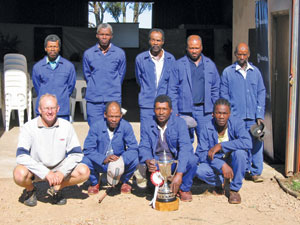
Goodwoods staff with the Mangold trophy for soil conservation which the business has won for three consecutive years. Back from left: Mzwandile Memani, Pindile Nini, Nono Gumenge, Mariri Breakfast and Patrick Mtwalo. Front from left: Justin Stirk, Milile Mapapu, Piksile Breakfast and Xolani Mpolweni.
Justin started planting a macadamia orchard in 2003 and calls the 10ha under macadamia trees (about 2 700 trees) his “retirement policy”. He expects to harvest about 3t of nuts per hectare this year. The variety, Beaumont, that he planted has some tolerance to the area’s strong coastal winds. Justin hopes to increase his harvest to 6t/ha as the trees mature. The price of unshelled macadamia nuts is currently R30/kg to R40/kg.
Nuts are harvested in mid-July and sold to the Green Farms Nut Company, the first privately owned macadamia processing plant in South Africa. “Macadamias are low maintenance – they really only need labour during picking time,” he explains. “They can also withstand drought – they don’t produce during drought but they don’t die.”
Cabbages are sold at the East London fresh produce market, and to hawkers who collect them on the farm, and the cherry bell peppers are sold to Carara Agro Processing in Grahamstown. He alternates these two cash crops to keep the soil healthy.
Justin has a permanent staff of 14 men and employs between 20 and 70 temporary workers, mainly from the Kenton/Port Alfred area, during the picking season. “The roads are so bad that even though Port Alfred is only 25km away we house and feed labourers during the season rather than take them home each night. It costs us less than the vehicle maintenance. The province does nothing to improve the roads.”
Justin hopes that the government will start supporting its commercial farmers. “Without them the country will land up facing a food crisis like many other African countries,” he says. “The continuous threat to our livelihood is damaging South Africa and the farmers’ morale. The government must realise that farming doesn’t come easy.
You have to have long-term commitment and passion. Handouts and a culture of expectation is a destructive way to farm. We’ve become a nation of takers and this is not serving the economy.” Like many commercial farmers in South Africa, he has livestock and crop knowledge and expertise that he is happy to share.
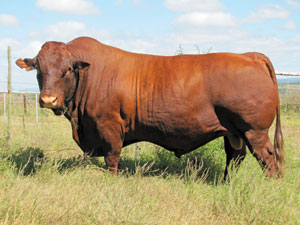
GCD 05 148, bred by Glynn Handley, will be on the 2012 Frontier Bonsmaras sale. One of his sons was sold for R300 000 at the Up George sale in KZN. His sire is the well-known bull EI94-339.
Partnering with emerging farmer Mninawa Qotoyi
In 2010, Frontier Bonsmaras started a partnership project with Bonsmara breeder Mninawa Qotoyi who farms in the Elliot district of the Eastern Cape. “There’s a big demand among emerging farmers for registered Bonsmara bulls and we decided to create a satellite stud with Mninawa called Mountain View Bonsmaras,” explains Justin. Frontier Bonsmaras provided 63 registered cows, that are doing well on Mninawa’s farm.
He keeps the heifer progeny and shares the bull progeny on a 50/50 basis with Frontier. Selected bulls will be sold on auction – the first in October 2013. Profits from culled bulls are shared on the same basis. Mninawa will pay Frontier Bonsmaras the slaughter price of the breeding cows it supplied him when they reach the end of their productive lives.
“It’s good doing business with Mninawa. He owns his own land, he is entrepreneurial and a well-respected farmer,” says Justin.
Growth testing
Justin does a semi-extensive Phase D growth test on his bulls shortly after weaning where he provides a production lick, such as Voermol or Supermol, on the veld. Bulls need to gain 1kg to 1,5kg a day and a total of 110kg from the start to the finish of the test. Those that don’t make sufficient gains are culled. Justin’s weaning weights for bull calves are from 240kg to 270kg and for heifer calves from 230kg to 250kg.
Contact Justin Stirk on 082 662 5901 or email [email protected]. This year’s Frontier Bonsmaras sale is on 15 August at the auction pens in Grahamstown. Visit Frontier Bonsmaras on www.frontierbonsmaras.co.za











